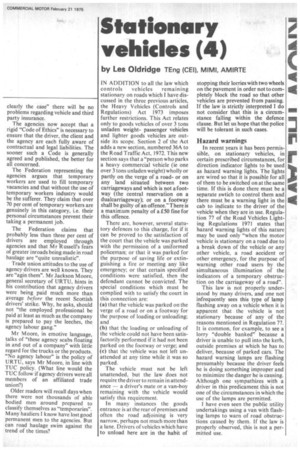Stationary vehicles (4)
Page 57

If you've noticed an error in this article please click here to report it so we can fix it.
by Les Oldridge TEng (CEO, MIMI, AMIRTE IN ADDITION to all the law which controls vehicles remaining stationary on roads which I have discussed in the three previous articles, the Heavy Vehicles (Controls and Regulations) A ct 1973 imposes further restrictions. This Act relates only to goods vehicles of over 3 tons unladen weightpassenger vehicles and lighter goods vehicles are outside its scope. Section 2 of the Act adds a new section, numbered 36A to the Road Traffic Act, 1972. This new section says that a "person who parks a heavy commercial vehicle (ie one over 3 tons unladen weight) wholly or partly on the verge of a roador on any land situated between two carriageways and which is not a footway (the central reservation on a dualcarriageway); or on a footway shall be guilty of an offence." There is a maximum penalty of a £50 fine for this offence.
There are, however, several statutory defences to this charge, for if it can be proved to the satisfaction of the court that the vehicle was parked with the permission of a uniformed policeman; or that it was parked for the purpose of saving life or extinguishing a fire or meeting any like emergency; or that certain specified conditions were satisfied, then the defendant cannot be convicted. The special conditions which must be complied with to satisfy the court in this connection are: (a) that the vehicle was parked on the verge of a road or on a footway for the purpose of loading or unloading; and (b) that the loading or unloading of the vehicle could not have been satisfactorily performed if it had not been parked on the footway or verge; and (c) that the vehicle was not left unattended at any time while it was so parked.
The vehicle must not be left unattended, but the law does not require the driver to remain in attendance — a driver's mate or a van-boy remaining with the vehicle would satisfy this requirement.
In many instances the goods entrance is at the rear of premises and often the road adjoining is very narrow, perhaps not much more than a lane. Drivers of vehicles which have to unload here are in the habit of stopping their lorries with two wheels on the pavement in order not to completely block the road so that other vehicles are prevented from passing. If the law is strictly interpreted I do not consider that this is a circumstance falling within the defence clause. But let us hope that the police will be tolerant in such cases.
Hazard warnings
In recent years it has been permissible, on stationary vehicles, in certain prescribed circumstances, for direction indicator lights to be used as hazard warning lights. The lights are wired so that it is possible for all of them to be switched on at the same time. If this is done there must be a separate swtich to control them and there must be a warning light in the cab to indicate to the driver of the vehicle when they are in use. Regulation 77 of the Road Vehicles Lighting Regulations 1971 states that hazard warning lights of this nature may be used only "when the motor vehicle is stationary on a road due to a break down of the vehicle or any other vehicle, a road accident or other emergency, for the purpose of warning other road users by the simultaneous illumination of the indicators of a temporary obstruction on the carriageway of a road".
This law is not properly understood by many drivers, and one not infrequently sees this type of lamp flashing away on a vehicle when it is apparent that the vehicle is not stationary because of any of the reasons mentioned in Regulation 77. It is common, for example, to see a lorry "double banked" because a driver is unable to pull into the kerb, outside premises at which he has to deliver, because of parked cars. The hazard warning lamps are flashing presumably because the driver feels he is doing something improper and to minimize the danger he is causing. Although one sympathizes with a driver in this predicament this is not one of the circumstances in which the use of the lamps are permitted.
I have even seen the public utility undertakings using a van with flashing lamps to warn of road obstructions caused by them. If the law is properly observed, this is not a permitted use.












































































































